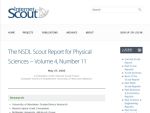History and Evolution of Physics
This Topic in Depth explores the history and evolution of the field of physics. The first website, created by the Institute of Physics, offers an interactive timetable of the development of physics from the ancient philosophers during the Bronze Age to the present research in quantum mechanics and relativity (1). The website illustrates the links between scientists and eras. Second, the US Department of Energy provides a synopsis of the work of the nuclear physics research program and the high-energy physics program since the 1950s (2). Users can also discover current research highlights and papers. The third website features an excerpt from a biography of Josiah Willard Gibbs by a student of his, Lynde Phelps Wheeler (3). Along with a download of a paper discussing the history of thermodynamics, the website supplies a download of a paper Carnot wrote about power in 1824. Fourth, physicist Patricia Schwartz presents a brief timeline of the evolution of mathematics and theoretical physics since the Babylonians established the metric of flat, two-dimensional space (4 ). Students can find an additional timeline of string theory dating back to the Kaluza-Klein Theory in 1921. The fifth website, developed by Lawrence Berkeley National Laboratory, is a section of an X-ray data book exploring the history of synchrotron radiation (5). The website discusses numerous historical aspects include the development of storage rings and the optimization of these with lower emittance and long straight sections for undulators. Sixth, John Bahcall, at the Institute for Advanced Study, offers popular papers on the history of solar neutrinos (6). Anyone interested in learning about the research of solar neutrinos should visit this website. The seventh website is a pdf file of a paper written by the President of the Italian Physical Society, Renato Angelo Ricci, detailing the work of Enrico Fermi and his contributions to the field of nuclear physics (7). This paper can help users who have some prior knowledge of nuclear physics understand the greatness of Fermi's work. Lastly, the University of Oxford provides images of scientific instruments from the medieval and renaissance periods of Europe held at four museums in Europe (8). Students can learn about the uses of the instruments and their origin.
Alternate Title
The Physics Evolution
Archived Scout Publication URL
Publisher
Classification
GEM Subject
Language
Date of Scout Publication
May 27th, 2005
Resource URL Clicks
6
Internal
Cumulative Rating
0
Resources




Comments